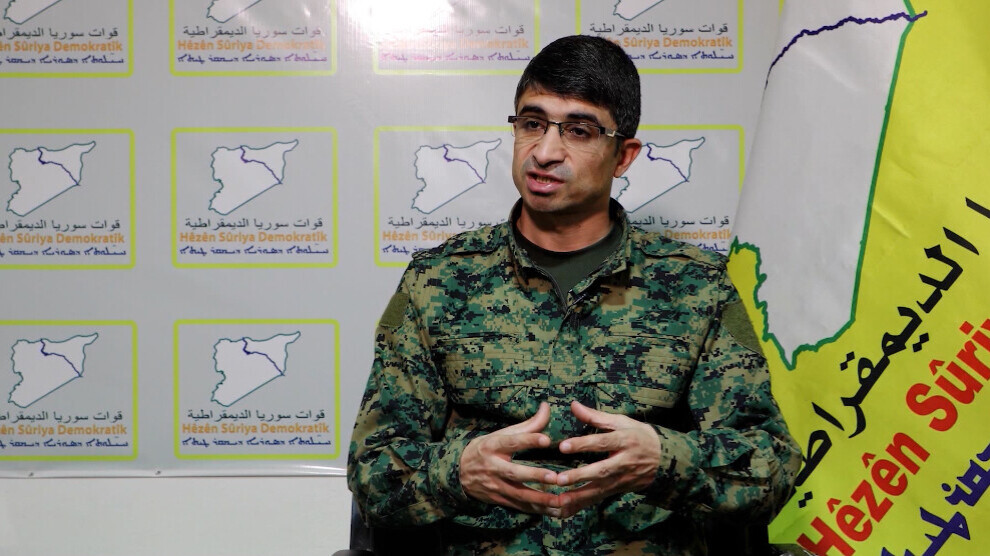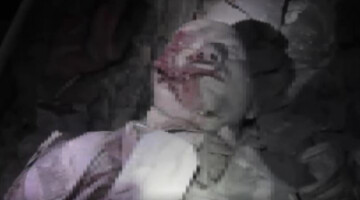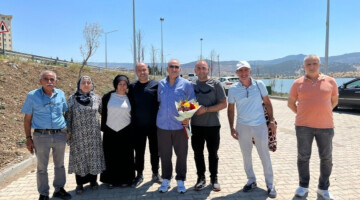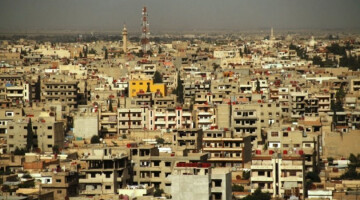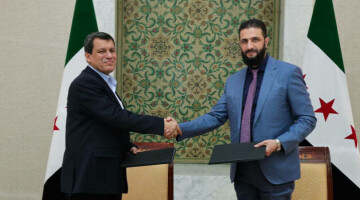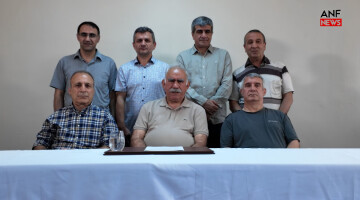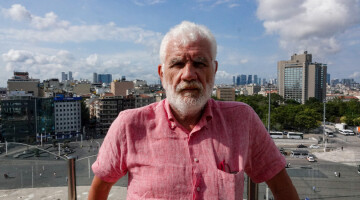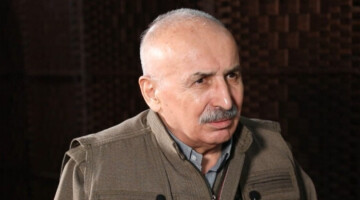In the wave of attacks launched by the Turkish state on the autonomous region of northern and eastern Syria in the night of 19-20 November, 16 civilians have been killed so far, including a 12-year-old. The attacks were directed against the population and infrastructure, hitting schools and clinics as well as energy supply facilities. However, security forces in Hol Camp and a prison for ISIS members in Qamishlo were also targeted. Eight fighters of the Syrian Democratic Forces (SDF) were killed in the attack in Hol Camp. ISIS supporters who tried to take advantage of the chaos that ensued after the airstrike to escape were captured by security forces.
The Hol reception and detention camp near Hesekê is home to over 50,000 people from over fifty different countries. Most come from Syria and Iraq, others from Europe, the Caucasus, North Africa and the Middle and Far East. Because the "Islamic State" was becoming increasingly active in the camp, the security forces of the Autonomous Administration of North and East Syria (AANES) launched an operation in March 2021 that uncovered secret ISIS cells and arrested nearly 300 ISIS supporters. Another operation began in August this year and lasted for several weeks. The Security Forces Command said that Hol Camp had become the centre of covert ISIS activities. According to the information, 44 people have been murdered in the camp this year, including 14 women and minors. Most of the murder victims appear to be deviants from ISIS doctrine. The operation freed several Yazidi women who had been abducted by ISIS from Shengal in 2014 and sold in slave markets. In north-eastern Syria, about 12,000 ISIS members are interned in prisons.
SDF Press Spokesman Ferhad Şamî spoke to ANF about the situation in Hol Camp and the prisons for ISIS members in the region.
What is the current situation in the Hol Camp and the ISIS prisons?
ISIS wants to use the current situation in the region as an opportunity to prove itself after taking out several commanders in Syria, north-eastern Syria and Iraq. Currently, desert areas in Syria are under ISIS control and movements are taking place in Homs, Deir ez-Zor and other areas on the border with Iraq. ISIS wants to capture new places and occupies villages every day. In northern and eastern Syria, pressure is mainly exerted on the population in Deir ez-Zor, sometimes also near Raqqa and in the south of Hesekê.
The ISIS cells operate mainly in the evenings and at night, collecting money as offerings, but using it for reorganisation. ISIS needs money and equipment for its activities and the money collected is no small sum. Of course, it has certain states behind it and large sums are also transferred from abroad, but domestically it finances itself through this method. According to the information we gained when we captured al-Bagouz [the last ISIS enclave in spring 2019], 20,000 ISIS members from abroad have disappeared. 46,000 Islamists of foreign origin had joined ISIS, of which 26,000 have been killed or arrested and the rest have disappeared. ISIS has withdrawn elementary cadres, especially in the battles in Mosul and Raqqa, and placed them in areas occupied by the Turkish state, such as Abu Bakr al-Baghdadi and other Islamists. According to our findings, there are fifty ISIS commanders in the occupied areas alone. In addition, there are thousands of other Islamists there. We have also communicated this to the International Coalition.
Turkey has targeted the Hol Camp and a prison. What danger does this pose?
Ultimately, ISIS wants to use the Turkish attacks for itself once again. In this regard, there is a lot of intelligence from the detention centres for ISIS members as well as from Hol Camp. In January, a large-scale attack took place on the Sina prison in Hesekê. This attack was only one aspect of the ISIS' plans. There are still covert cells in the region, and we are taking action against them every day. ISIS needs a leadership structure and its commanders are currently imprisoned. They should be freed so that ISIS can reorganise. Hol Camp is more of an ideological space for ISIS. However, there is a military and an ideological area there. This was found during our last humanitarian security operation. No weapons were found in the area used for training, but military equipment was seized in the other area. So, ISIS is reorganising itself on two levels in Hol Camp.
In recent months, children as young as two years old have been discovered in the area for foreign women. This has not been reported publicly so far. How do these children get there? There are no men in the sector for foreign women. It seems that marriages are being contracted with minors. By marrying boys at the age of 12 or 13, procreation is ensured. For this reason, children of this age are now taken out of the sector by the security forces.
In north-eastern Syria, 65,000 ISIS members are currently interned in camps and prisons, of which 12,000 are in detention centres. The prisoners are commanders from 60 countries. ISIS has undertaken various offensives for their liberation and wants to use the attacks of the Turkish state as an opportunity. Eight Islamist attack attempts have taken place within 20 days. One of them was directed against Hol Camp, while the others targeted the prison in Hesekê as well as the region around Raqqa and Deir ez-Zor and the south of Hesekê. The Turkish attacks on Kobanê were intended to give hope to ISIS. Mekmen was bombed by the Turkish air force. The village is 80 kilometres away from the Turkish border at a strategically important location between Raqqa, Deir ez-Zor and Hesekê. With the liberation of Mekmen, Deir ez-Zor and Raqqa could also be liberated at that time. ISIS carried out numerous attacks in Mekmen and tried to come back to life there. And the Turkish state deliberately bombed Mekmen. This is not a coincidence, but a retaliatory strike against ISIS. ISIS has used the Turkish bombings as an opportunity to carry out eight attacks of its own. While we are busy with the Turkish wave of attacks, we had to repel eight ISIS attacks at the same time.
Are sufficient measures being taken?
Attention must be paid to those in the prisons and camps. There are ISIS members from over 50 countries in Sina prison alone. Most ISIS members from Europe are in prison. There are also people from various countries of origin in the camps. Many of them were children but have since grown up and been educated with the radical ideas of ISIS. They are like a time bomb in our hands. Hol Camp in particular is now less a reception camp and more a military camp. The Turkish state does not consider ISIS a terrorist organisation, but calls it an armed organisation. What will happen in Hol Camp and the prisons in the future is completely unclear at the moment. These places pose a danger. Prisons are being rebuilt and money is being spent on them, but it is not enough. In the end, it is of no use. It is only a temporary measure.
First of all, trials against ISIS members must take place in our region. We say that these trials must be held here because the prisoners are here with us. Moreover, the people who have suffered under ISIS live here, and there are five million people. Moreover, we have the evidence of the crimes committed. Some states argue that the trials should take place elsewhere. However, that would make no sense because the five million witnesses cannot be brought there. Likewise, it is hardly feasible to transfer such a large number of prisoners to another location. Basically, this is meant to fragment the whole trial, it is not meant to be about ISIS as a whole. However, ISIS is not a collection of individual cases. We have not fought against individuals, but against a mentality. Since the ISIS caliphate was crushed in 2019, about 3000 ISIS members have been repatriated to Iraq and about 2000 from other countries of origin. This is not enough, because there are 65,000 ISIS members in our country. If it continues at this rate, they will stay here for another 25 years. A solution must be found. A court must be established or each country must take back its own ISIS members.
Control over the Islamists is not only the responsibility of the autonomous region, but also of the international coalition. To what extent are the states represented in the anti-ISIS coalition taking care of the matter? Are you holding talks with the coalition on this matter?
Of course, such talks are taking place. These 85 countries are in our region as an international coalition. However, they are doing very little to provide intelligence or other support to the SDF. This is not enough for the fight against ISIS. Much more support is needed for both the military fight and society. ISIS has caused great destruction in the region, our infrastructure has been destroyed, many schools are ruins, facilities for electricity and water supply are broken, towns and villages have been looted and destroyed. We need direct support for reconstruction. In addition, the region must also be politically recognised in the long term. The fight against ISIS is not only on a military level, but also on a political and ideological level. As long as our region does not receive official recognition, the ISIS threat will remain and the Turkish state will continue to support ISIS. We have talked about this at length with the coalition.
The coalition admits that the fight against ISIS has no chance of success without the SDF and the YPJ/YPG. Only Turkey does not admit to this, but it finances ISIS anyway. Apart from the SDF, there is no force that can fight ISIS. If this fight is to produce results and ISIS is not to threaten all of humanity again, the SDF must be supported more strongly.
There are investigation results on the attack on the ISIS prison in Hesekê, which will be published in the coming time. Camps and prisons are under the ISIS command and are commanded by the respective commanders. These commanders were located in Idlib and Afrin in the past, as they are today. This was confirmed during the investigation of the attack in Hesekê. One and a half months ago, three ISIS members were captured who wanted to establish a cell for another attack on the prison. The captured mercenaries had been trained in camps in Turkish-occupied Serêkaniyê. Their statements will also be made public in the near future.

